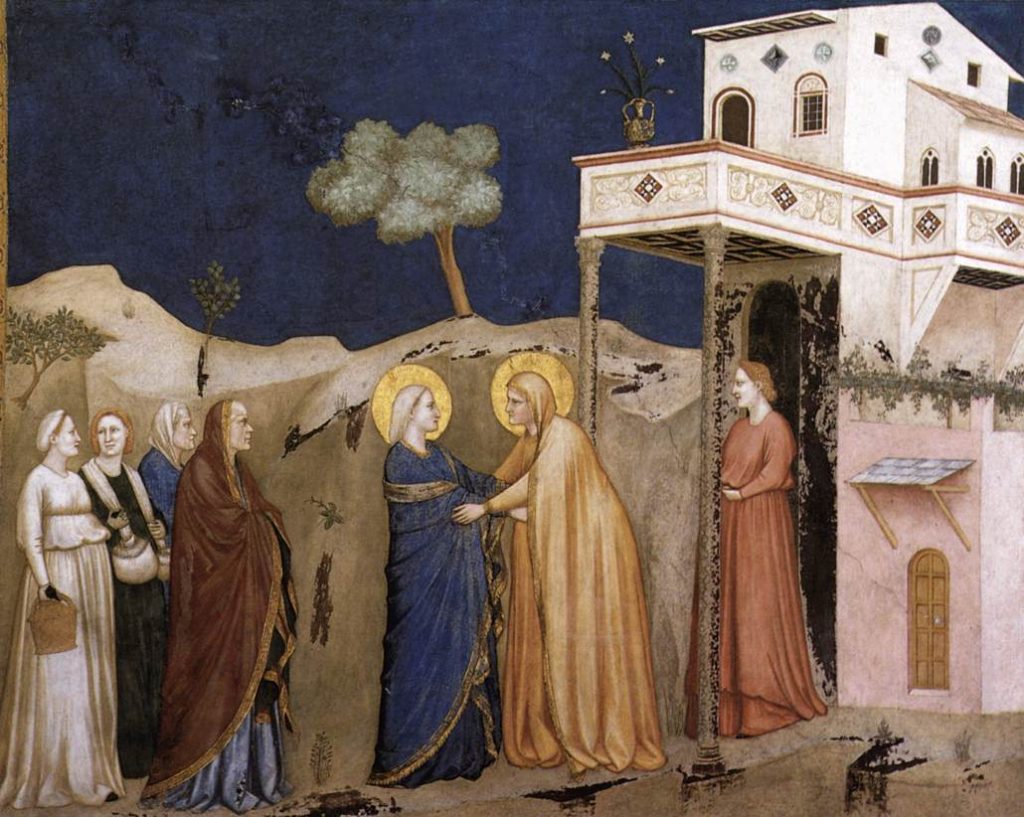Magnificat!

The Feast of the Visitation is the remembrance of Mary’s visit to her cousin Elizabeth as recorded by the holy evangelist, St. Luke. In the first chapter of his Gospel, St. Luke tells of not one but two miraculous conceptions. The first is that of John the Baptist to the barren Elizabeth and Zechariah, and the second is that of Our Lord to Mary.
Immediately after the angel Gabriel visits Mary and announces that she is with child by the Holy Spirit, Mary leaves for a town in Judea where her older cousin Elizabeth lives. At this point, Elizabeth has been with child for six months (Luke 1).
When Elizabeth sees Mary, John the Baptist leaps within her, and she is filled with the Holy Spirit. Much as Israel had shouted for joy in the presence of her Lord in the Ark of the Covenant, Elizabeth cries out and responds in song. In a further parallel to the Ark, which stayed in Obed-edom’s house for three months (2 Samuel 6:11), Mary, the ark of the Lord whom she bears, remains with Elizabeth three months. Thus, Dr. Arthur Just suggests, this visit of the Blessed Mother fulfills and is the archetype of the Ark of the Covenant, where God has chosen to be present.
Mary’s response back to Elizabeth is to magnify her Lord and his great deeds—that “he has brought down the mighty from their throne and exalted those of humble estate…” and “…He has helped his servant Israel, in remembrance of his mercy…” (Luke 1:46-55). Known as The Magnificat, this liturgical song has remained on the Church’s lips for millennia, continuing to this day in her offices of Vespers and Evening Prayer.
Mary’s womb is the new Holy of Holies, and here we have the first instance of creation responding to the incarnational reality of Jesus’ presence. Together with Mary, Elizabeth, and John the Baptist, we join in celebrating that our Lord was made flesh and remember Mary’s visit to Elizabeth on July 2nd.

Brief History
The Feast of the Visitation is just one in a series of feasts the Church observes honoring the mother of our Lord. Other holy dates on our Lutheran calendar that highlight Mary include the August 15th commemoration of Mary herself as well as the Annunciation, celebrated on March 25th. Roman Catholics observe many more feasts that the Blessed Virgin Mary, and the Eastern Orthodox liturgical calendar, which has twelve great feasts (beside Easter), is bookended by two feasts of the Theotokos: Mary’s nativity (Sept. 8) and her dormition (August 15).
Unlike some of the aforementioned holidays, the Visitation is a later addition to the Church’s calendar. It was first formally added to the calendar by Pope Urban VI in 1389 and falls on July 2nd. The Lutheran Church—Missouri Synod’s one-year lectionary cycle retains this historic date for the observance of the Visitation. However, with the new Roman Catholic lectionary that arose in the wake of the Second Vatican Council, the Roman Church shifted its observance of the Visitation to May 31st. This date quickly became popular, and the Missouri Synod’s three-year lectionary gives the newer May date for this feast.
Collect
Almighty God, who hast dealt wonderfully with Thy handmaiden, the Virgin Mary, and hast chosen her to be the mother of Thy Son and hast graciously made known that Thou regardest the poor and lowly and the despised: grant us grace in all humility and meekness to receive Thy Word with hearty faith, and so to be made one with Jesus Christ, Thy Son, our Lord, who liveth and reigneth with Thee and the Holy Ghost: ever one God, world without end. Amen.
Resources
Issues, Etc. interview with the Rev. Dr. Arthur Just on the Visitation
Propers found in Daily Divine Service Book: A Lutheran Daily Missal, edited by the Rev. Heath Curtis
References:
1. Weedon, William. Celebrating the Saints. Concordia Publishing House. 2016.
Images:
1. The Visitation, from The Life of the Virgin, Albrecht Dürer, Germany, 1504.
2. The Visitation, Giotto di Bondone, Italy, 1310.
Some links might be affiliate links which means we may receive a small commission at no extra cost to you. As an Amazon Associate we earn from qualifying purchases.




[…] relative terms, the Feast of the Visitation is a more recent addition to the liturgical calendar. It was not added to the calendar until 1389, […]